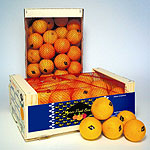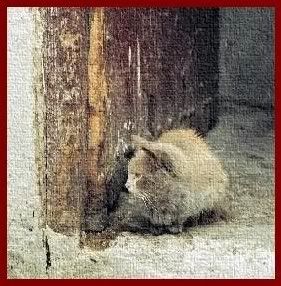My Darling Clementine ...
 Christmas has come to Morocco. Not in the shape of reindeer or Santas or nativity scenes but in something far more resonant of the holidays, something that hints at a reprieve from a long dark frigid Canadian winter ... the Moroccan clementine.
Christmas has come to Morocco. Not in the shape of reindeer or Santas or nativity scenes but in something far more resonant of the holidays, something that hints at a reprieve from a long dark frigid Canadian winter ... the Moroccan clementine.When I was a girl - falling roughly sometime between the Industrial Revolution and the advent of the Gameboy - Christmas was a thing of wonder. My parents always made certain that everything that my brother & I could possibly want was under the tree Christmas morning. And then some. Christmas was sacred to my mother - she took it seriously and threw herself into every aspect of celebrating the holiday with complete abandon, enthusiasm and an eye for detail that bordered on disturbing. My father's chief duty lay in anchoring the Christmas tree to the wall with the help of an electric drill and a series of eyelet screws and twine. Sometimes it worked, sometimes our mountaineering family cats prevailed. Over the years, Dad maintained that my mother still believed in Santa Claus, and maybe he was right. That would go a long way to explain her ability to enfuse our home with the Christmas spirit.
Having said that, it used to drive me crazy that my parents would go on & on about the freaking oranges which, if they were lucky, bulged at the base of their Christmas stockings when they were kids. And yes, I understood then, as I do now, that in the 1930's & 40's, the appearance of citrus fruit during the depths of a dismal December was truly a remarkable thing. Knarf & I invariably found oranges in the big toe of our stockings (making our already over-stuffed stockings look like an anaconda in the latter stages of digesting a wild boar) but we dismissively deposited them into the crystal fruit bowl. Oranges - in tale and in the flesh - were tiresome and just not that exciting, especially when an Easy-Bake oven was awaiting its inaugral batch of brownies.
Up until my father's death, both of my parents always ensured that a gargantuan orange lay hidden at the bottom of the other's Christmas stocking. They even ate them.
Not that long ago, in response to a devastating cold snap in Florida which annihilated its orange crop, wooden crates of Moroccan clementines began to pop up in Canada. The first clementine, however, appeared in North Africa at the turn of the last century - or the next to last, depending how your internal clock is set. Legend has it that the modern fruit is a descendant of a mandarine and a sour orange, a hybrid produced by Father Clement Rodier, an Algerian priest, in the garden of his orphanage; however, the Chinese claim that they discovered the clementine first. With the complete absence of a poignant anecdote, any etymological evidence (however spurious), and in light of their flagrant human rights abuses, I am dismissing China's claim to the fruit. In 1925, the tiny tangerines crossed the Med and rolled into Spain. The rest, as they say, is history.
Now they are in the Great White North; in 2004 alone, Canada imported almost $39 million worth of these well-travelled fellows. I for one rejoiced at their arrival: I never could get the knack of peeling oranges and I still can't. In my mind, oranges are too labour intensive and are just as likely to disappoint the taste buds as not; frankly, they aren't worth it. But inside these wooden treasure chests, kept secure with plastic mesh, dozens of brilliantly coloured & head-reelingly aromatic clementines - each bearing a little black diamond-shaped "Maroc" sticker - promised untold gastronomic delights.
And they did not disappoint. With peels that even I - the citrus-retard - could open, and 12 (an auspicious number, no?) succulent seedless wedges of North African sunshine, all enveloped in (what seemed to me then) the heady exoticism of Morocco, this David of fruits elbowed its way into the Christmas market, eventually surplanting the Goliath Florida orange and becoming a holiday staple. The first sighting of the little wooden boxes from Morocco is quite coveted, and is consequently widely broadcast through word of mouth as well as on the radio. In towns bereft of a Santa Claus parade, the arrival of the clementines signals the Christmas season in earnest.
And now the mandareen are here. In abundance. Stacked in boxes outside of hanoots, arranged in pyramids in grocery stores, vying for sidewalk space with beggars, or piled in baskets suspended across the bicycles of itinerant fruit-sellers - they are everywhere. For weeks to come, clementines will be heaped in bowls in our kitchen and living room, suf
 fusing the air with their fragrance. Locals claim that the choicest fruit is bestowed with the much desired Maroc label and then exported to foreign tables, leaving Moroccans with the dregs. But oh such dregs! To my uncultured palate the Mahgrebi homebodies are just as sweet and just as juicy as their jetsetting compatriots. In fact, ours have something better than those little black labels: stems and leaves - an umbilical cord if you will, linking my Christmases past and present, a cycle which begins in my adopted home and finds fruition in the place of my birth.
fusing the air with their fragrance. Locals claim that the choicest fruit is bestowed with the much desired Maroc label and then exported to foreign tables, leaving Moroccans with the dregs. But oh such dregs! To my uncultured palate the Mahgrebi homebodies are just as sweet and just as juicy as their jetsetting compatriots. In fact, ours have something better than those little black labels: stems and leaves - an umbilical cord if you will, linking my Christmases past and present, a cycle which begins in my adopted home and finds fruition in the place of my birth.And at such ludicrously cheap prices - some 50 cents a kilogram - Mr. Cat in Rabat and I will be eating them until we can't bear the sight of them. Fortunately that won't happen - they'll disappear long before that.








11 Comments:
As the brother about whom you obliquely refer (okay, your reference wasn't oblique, I just wanted to say "oblique"), I have to tell you, I was misting, reading the first part of today's blog (about our Christmases), I laughed in the middle, and smiled at the end.
What a wonderful piece of writing!
Thank you for making my day.
*blush*
Oh God, I loooooooooove clementines. Thanks for the great post!
BUT (and I surely don't mean this as criticism) you should have mentioned about how dad would cut branches off the "thick" areas of the tree, then painstakingly drill holes in the trunk at the "bare" areas of the tree, and glue said branches into the trunk, thus "evening out" the tree.
Indeed, his trees were marvels of engineering and ingenuity...
You're absolutely right Knarf - that was a gross oversight on my part.
I wouldn't say it was gross...
;-)
Besides, let's face it, there are so many Christmas stories we could tell, that would be a week's worth of long blogs.
Remember when the real Santa showed up in the basement of 78 Conway?
That was brilliant.
I love your writing, that said this post was simply superbly delicious.
Thanks for the smiles as I read through it.
Had to laugh over your rejection of the Chinese claim ... when the 'kiwi fruit' first arrived in New Zealand, during my childhood, they were known as Chinese Gooseberries so yeah ... who remembers that.
Oh, just read other comments before posting ... and saw knarf being sweet. See ... it was THAT good :)
What a beautiful story! Bravo Cat!
God bless us, everyone. Sniff.
great story, really enjoyed it.
myself a moroccan living in texas, I am missing these sweet clementines from morocco. for some reason you cannot buy them in texas. I would pay a fortune to buy them.
Post a Comment
<< Home